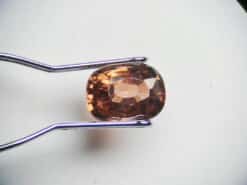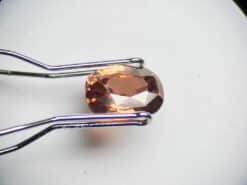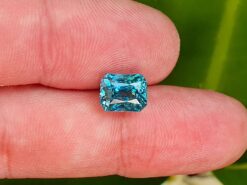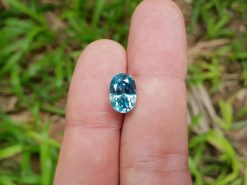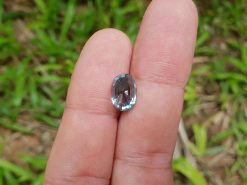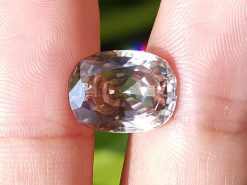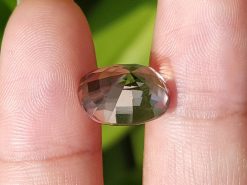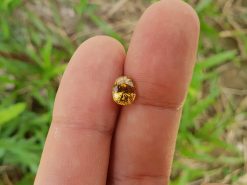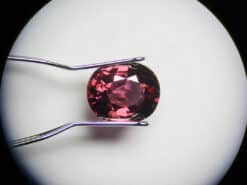Blue zircon
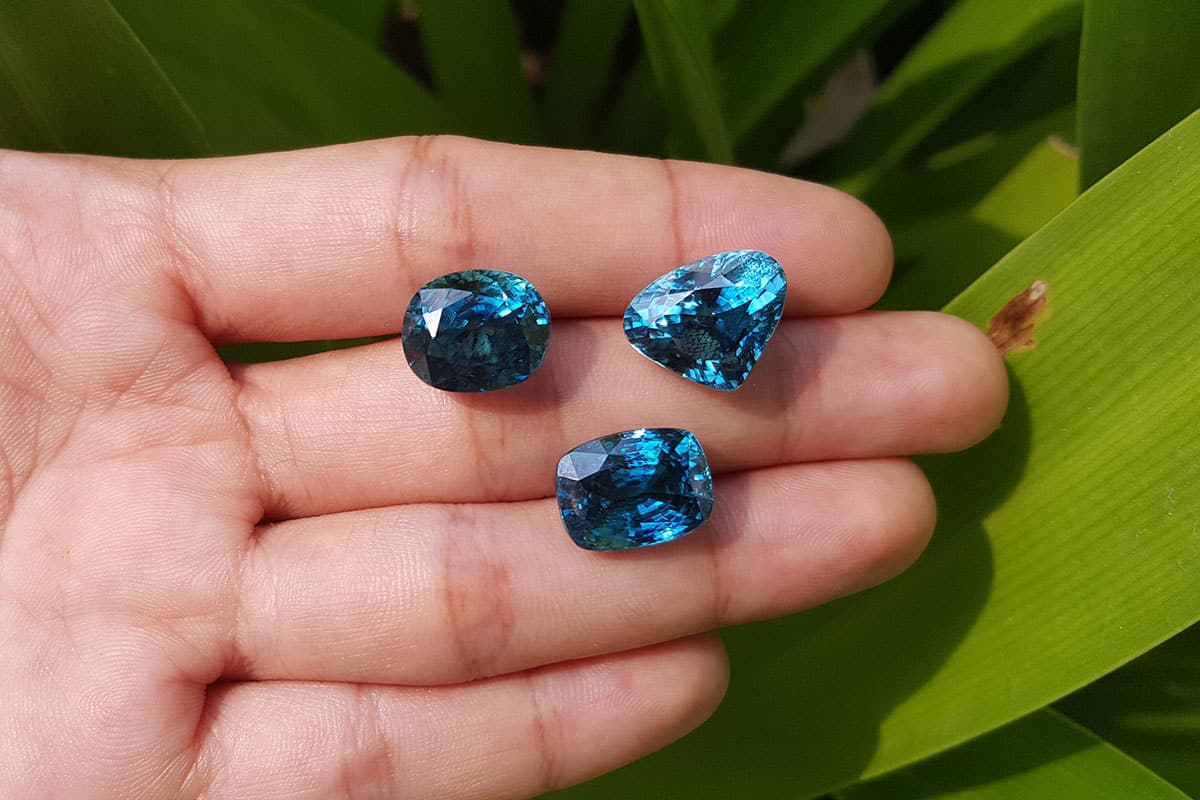
Blue zircon stands as one of nature’s most brilliant yet underappreciated treasures. With its remarkable brilliance, exceptional clarity, and mesmerizing azure hues, blue zircon offers a stunning alternative to more expensive blue gemstones. This comprehensive guide explores everything you need to know about this extraordinary gemstone, from its geological formation to its place in modern jewelry collections.
What is Blue Zircon? Definition and Mineralogical Characteristics
Blue zircon is a natural gemstone variety of the mineral zircon, which has the chemical composition ZrSiO4 (zirconium silicate). Despite sharing a similar name with cubic zirconia (a synthetic diamond simulant), zircon is a completely different and natural gemstone with a rich geological history.
The distinctive blue color of blue zircon is typically achieved through heat treatment of brownish zircon, although rare natural blue specimens do exist. The resulting gemstone exhibits exceptional brilliance and fire, with optical properties that rival even diamond.
Key Mineralogical Properties of Blue Zircon
- Crystal System: Tetragonal
- Mohs Hardness: 7-7.5, making it moderately durable
- Specific Gravity: 3.90-4.73 (relatively high, giving it substantial heft)
- Luster: Adamantine to vitreous
- Cleavage: Indistinct
- Fracture: Conchoidal
- Transparency: Transparent to translucent
What distinguishes blue zircon mineralogically is its unique internal structure. The gemstone contains trace amounts of uranium and thorium, which gradually break down over millions of years and can affect the crystal lattice. This process, coupled with heat treatment, contributes to the development of the captivating blue hues that make this gemstone so desirable.
Origins and Geographical Sources of Blue Zircon
Blue Zircon Mining Locations
Cambodia stands as the source of the finest blue zircons in the world. The Ratanakiri Province in northeastern Cambodia is particularly renowned for producing high-quality zircons that, when heat-treated, transform into the most coveted blue specimens. The region’s zircons are often referred to as “Ratanakiri zircon” in the gem trade, signifying their superior quality.
The geological conditions in Cambodia create zircons with particular trace elements that, when heated, produce the most electric and vibrant blue hues. These stones typically display strong color saturation and consistent coloration.
Mining and Extraction Methods
Blue zircon is typically extracted through alluvial mining methods, where deposits are found in stream beds and riverbanks. Miners sift through gravel and sediment to locate the gemstones, which have been naturally separated from their host rock through erosion and water action.
In some locations, particularly in Cambodia, mining is often conducted using traditional, small-scale techniques by local communities. These artisanal mining operations are an important part of the local economy but can also present challenges in terms of environmental impact and working conditions.
Modern mining operations increasingly implement more sustainable practices, including land reclamation and water management systems to minimize ecological damage. As consumer awareness grows, ethically sourced blue zircon is becoming an important consideration for buyers concerned with environmental and social responsibility.
Historical Significance and Cultural References of Zircon
zircon carries a rich history that spans centuries, appearing in various cultural traditions and historical contexts. Its journey through human civilization offers fascinating insights into how this gemstone has been valued and used through the ages.
Zircon in Ancient Civilizations
Zircon is one of the oldest minerals on Earth, with some crystals dating back 4.4 billion years. While not specifically blue zircon, the mineral itself has been known to humans since ancient times. Historical records indicate that zircon was appreciated in various cultures:
- Ancient Greece and Rome: Zircon was known and used in jewelry and as talismans
- Middle Ages: Blue zircon specifically was thought to promote sound sleep, drive away evil spirits, and bring prosperity and wisdom
- Victorian Era: Blue zircon gained popularity as an alternative to more expensive blue gemstones like sapphire
In Hindu mythology, zircon had associations with the Kalpa Tree, which was said to fulfill wishes. In medieval times, blue zircon was believed to protect travelers and help them find hospitality during their journeys.
Zircon in Modern History
During the Art Deco period of the 1920s and 1930s, zircon experienced a surge in popularity. Its vibrant color and extraordinary brilliance made it ideal for the bold, geometric designs characteristic of this artistic movement. Many vintage Art Deco pieces featuring blue zircon can be found in collections and auctions today, testifying to its enduring appeal.
In the 1940s and 1950s, zircon was often used as an alternative December birthstone to turquoise and tanzanite. Its affordability and brilliant blue color made it accessible to a wider audience seeking birthstone jewelry.
Today, zircon continues to be appreciated for its natural beauty and increasing rarity. As older deposits become depleted and new mining regulations affect production, vintage blue zircon jewelry has gained value among collectors and enthusiasts of historical gemstones.
Gemological Properties of Blue Zircon
Blue zircon possesses remarkable gemological properties that set it apart from other blue gemstones. Its optical characteristics, in particular, make it one of the most brilliant natural gemstones available.
Color Variations and Characteristics
The blue color in zircon occurs in several distinctive shades:
- Sky Blue: Light, airy blue reminiscent of a clear sky
- Electric Blue: Vibrant, saturated blue with high intensity (often the most valuable)
- Teal Blue: Blue with greenish undertones
- Ice Blue: Pale blue with exceptional clarity and brilliance
- Deep Blue: Dark, saturated blue (less common)
The blue color in zircon is typically caused by heat treatment, which affects the valence state of trace elements within the crystal structure. Natural blue zircon does exist but is extremely rare. The heat treatment process typically transforms brownish or reddish zircon into blue by altering the way the crystal absorbs and reflects light.
An interesting characteristic of blue zircon is its pleochroism – the ability to show different colors when viewed from different angles. Blue zircon typically exhibits dichroism, showing blue in one direction and a slightly different blue or bluish-green in another direction.
Optical Properties
Blue zircon boasts exceptional optical properties that contribute to its remarkable beauty:
- Refractive Index: 1.925-1.984 (exceptionally high, giving it incredible brilliance)
- Dispersion: 0.039 (higher than many gemstones, resulting in excellent fire)
- Birefringence: 0.059 (high, causing the distinctive doubling of facets visible under magnification)
The combination of high refractive index and strong dispersion gives blue zircon a brilliance and fire that approaches that of diamond, making it one of the most sparkly colored gemstones available. This property makes blue zircon particularly attractive in well-cut specimens, where the facets can maximize the display of these optical characteristics.
Clarity, Cut, and Carat Weight
Clarity: Blue zircon typically has excellent clarity, with most gem-quality specimens being eye-clean (no visible inclusions to the naked eye). Under magnification, blue zircon may display some inclusions, including:
- Growth tubes or lines
- Tiny mineral inclusions
- Internal stress fractures (particularly in heat-treated specimens)
Cut: Due to its high brilliance and fire, blue zircon is often cut in styles that maximize these properties:
- Brilliant cuts (round, oval, cushion) are popular for showcasing the stone’s sparkle
- Step cuts (emerald, asscher) can highlight the color and clarity
- Mixed cuts combine brilliant-cut crowns with step-cut pavilions for optimal light performance
Blue zircon has a directional hardness, meaning it’s slightly harder in some directions than others. This characteristic requires skilled cutting to avoid damage during the faceting process and to properly orient the color for maximum saturation.
Carat Weight: Blue zircon is available in a wide range of sizes, from small accent stones under 1 carat to impressive specimens over 10 carats. Due to its relatively high specific gravity, blue zircon appears smaller than many other gemstones of the same weight – a 1-carat blue zircon will appear smaller than a 1-carat diamond or sapphire.
Typical sizes for blue zircon in jewelry range from 1 to 5 carats, with stones over 10 carats being relatively rare but still more affordable than comparable blue sapphires or diamonds.
Treatments and Enhancements for Blue Zircon
Understanding the treatments applied to blue zircon is essential for both buyers and collectors, as most blue zircon on the market has undergone some form of enhancement to achieve its attractive color.
Heat Treatment Process
Heat treatment is the most common enhancement for blue zircon. The process typically involves:
- Heating brownish, reddish, or yellowish zircon crystals to temperatures between 800-1000°C
- Maintaining the temperature for a specific period (usually several hours)
- Controlled cooling to stabilize the color change
This treatment alters the valence state of trace elements within the crystal, particularly uranium and thorium, changing how the stone absorbs and reflects light. The result is the transformation from earthy colors to brilliant blue hues.
Heat treatment of zircon is considered permanent under normal wearing conditions, though prolonged exposure to strong light or heat can sometimes cause the blue color to fade over time. This treatment is universally accepted in the gemstone industry and does not negatively impact the value of blue zircon when properly disclosed.
Brown zircon turns to blue after heat treatment
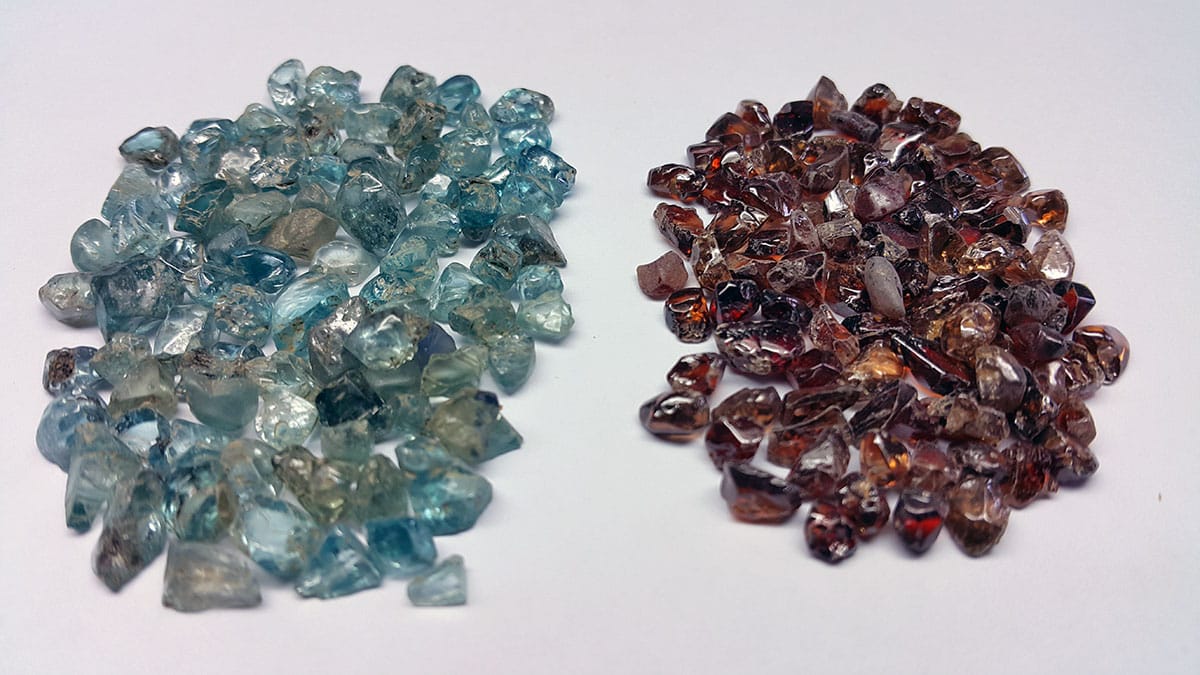
Stability and Care Considerations for Treated Stones
Heat-treated blue zircon requires specific care considerations:
- Color stability may be affected by prolonged exposure to strong sunlight or heat
- The crystal structure can become more brittle after heat treatment, requiring more careful handling
- Ultrasonic cleaners should be avoided as they may damage heat-treated stones
Gem laboratories can typically identify heat-treated blue zircon through spectroscopic analysis and by examining internal features characteristic of the treatment process. Naturally blue zircon (without treatment) is extremely rare and commands significantly higher prices when certified as natural-color.
Other Potential Treatments
While heat treatment is by far the most common enhancement for blue zircon, other treatments occasionally encountered include:
- Irradiation: Sometimes used to intensify or alter color (much less common than heat treatment)
- Clarity Enhancement: Surface-reaching fractures may occasionally be filled to improve appearance
- Coatings: Very rarely, surface coatings may be applied to enhance color (generally considered unstable and not recommended)
When purchasing blue zircon, it’s important to ask about all treatments that may have been applied to the stone. Reputable dealers will always disclose this information, which should also be noted on any accompanying certification for significant stones.
How to Distinguish Blue Zircon from Similar Blue Gemstones
With its vivid blue color, blue zircon can sometimes be confused with other blue gemstones such as blue topaz, aquamarine, and even blue sapphire. Understanding the distinguishing characteristics helps in proper identification and appreciation of blue zircon’s unique qualities.
Blue Zircon vs. Blue Topaz
Blue topaz is perhaps the most common blue gemstone that blue zircon is mistaken for, as both can exhibit similar colors and are widely available.
Key differences include:
- Brilliance and Fire: Blue zircon has significantly higher brilliance and dispersion than blue topaz, creating more sparkle and colorful flashes
- Specific Gravity: Blue zircon is notably heavier than blue topaz when compared in the same size
- Doubling Effect: Under magnification, blue zircon often shows a characteristic doubling of the facets due to its high birefringence, which is absent in blue topaz
- Color Distribution: Blue zircon often has a slightly uneven color distribution with subtle teal undertones, whereas blue topaz typically has a more uniform color
- Price: Blue zircon is generally more expensive than blue topaz, which is widely available in large sizes at affordable prices
Blue Zircon vs. Aquamarine
Aquamarine, a variety of beryl, can sometimes be confused with lighter shades of blue zircon.
Distinguishing features include:
- Color Tone: Aquamarine typically has a softer, more pastel blue color compared to the often more electric or vivid blue of zircon
- Brilliance: Blue zircon displays markedly higher brilliance and fire than aquamarine, which has a more subdued luster
- Inclusions: Aquamarine often contains characteristic tube-like inclusions, while blue zircon typically has different inclusion patterns
- Crystal Structure: Aquamarine forms in hexagonal crystals, while zircon forms in tetragonal crystals (relevant for rough specimens)
Blue Zircon vs. Blue Sapphire
High-quality blue zircon can sometimes be mistaken for blue sapphire, especially in certain lighting conditions.
Key differences include:
- Brilliance and Dispersion: Blue zircon has greater fire and brilliance than blue sapphire, which has a more velvety appearance
- Hardness: Blue sapphire (9 on the Mohs scale) is significantly harder than blue zircon (7-7.5)
- Inclusions: Blue sapphire typically has different inclusion patterns, including silk-like rutile inclusions that are not present in zircon
- Price: Fine blue sapphire is substantially more expensive than blue zircon of comparable size and quality
Simple Tests for Identification
Several simple observations can help distinguish blue zircon:
- Observe with a loupe: The facet-doubling effect visible in blue zircon is a distinctive identifying feature
- Check the weight: Blue zircon will feel heavier than most similar-looking blue stones of the same size
- Examine brilliance: The exceptional sparkle of blue zircon sets it apart from most other blue gemstones
- Use a spectroscope: Blue zircon has a characteristic absorption spectrum different from other blue gems
For definitive identification, professional gemological testing using equipment such as a refractometer, specific gravity testing, or advanced spectroscopic analysis may be necessary. When purchasing significant blue zircon specimens, certification from a reputable gemological laboratory provides assurance of proper identification.
Natural zircon from Ratanakiri, Cambodia
Care Instructions and Maintenance for Blue Zircon
Blue zircon, while beautiful and durable enough for most jewelry applications, requires specific care to maintain its brilliance and structural integrity. Understanding how to properly care for blue zircon will ensure it remains beautiful for generations.
Everyday Wear Considerations
With a hardness of 7-7.5 on the Mohs scale, blue zircon is durable but not as hard as sapphire or diamond. This means certain precautions should be taken:
- Avoid Impact: Blue zircon can chip or fracture if struck against hard surfaces
- Remove During Rough Activities: Take off blue zircon jewelry when engaging in sports, gardening, or household chores
- Last On, First Off: Put on blue zircon jewelry after applying cosmetics, hairspray, and perfume, and remove it before showering or swimming
- Avoid Temperature Shocks: Blue zircon can be sensitive to sudden temperature changes, which may cause fractures
- Protect from Prolonged Sunlight: Extended exposure to strong sunlight can gradually fade the color of heat-treated blue zircon
Blue zircon is particularly susceptible to damage along facet edges and corners, so protective settings that shield these vulnerable areas are recommended for everyday wear pieces.
Cleaning Methods for Blue Zircon
Proper cleaning techniques will keep your blue zircon looking its best:
- Regular Cleaning: Clean blue zircon with a soft brush and mild soap in warm (not hot) water
- Drying: Pat dry with a soft, lint-free cloth rather than air drying
- Avoid Ultrasonic Cleaners: The vibrations can exacerbate any internal fractures
- Avoid Steam Cleaners: The heat and pressure can potentially damage heat-treated stones
- No Harsh Chemicals: Avoid household cleaners, bleach, chlorine, and other chemicals that can damage both the stone and its setting
For professional cleaning, always inform your jeweler that the piece contains blue zircon so they can use appropriate and safe cleaning methods.
Storage Recommendations
Proper storage is crucial for preserving the beauty of blue zircon jewelry:
- Individual Storage: Store blue zircon pieces separately in soft pouches or lined compartments to prevent scratching
- Climate Control: Keep in a relatively stable environment, avoiding extreme temperature or humidity fluctuations
- Light Protection: Store away from prolonged direct sunlight to prevent potential color fading
- Anti-tarnish Strips: If the blue zircon is set in silver, using anti-tarnish strips in the storage area can help preserve the setting
With proper care and storage, blue zircon can maintain its beauty for many years. Periodic professional inspection is recommended, particularly for pieces worn regularly, to check for loose settings or signs of wear that might need attention.
Blue Zircon in Jewelry and Current Market Trends
Blue zircon has established itself as a desirable gemstone in the jewelry market, offering exceptional brilliance and color at a more accessible price point than many other blue gemstones. Understanding current trends and uses helps in appreciating the stone’s place in contemporary jewelry.
Popular Jewelry Applications
Blue zircon is versatile enough to be used in various jewelry styles:
- Engagement Rings: As an alternative center stone for couples seeking something unique and meaningful
- Cocktail Rings: Large blue zircons make stunning statement pieces
- Earrings: The exceptional brilliance makes blue zircon particularly effective in earrings, where movement enhances the play of light
- Pendants and Necklaces: Particularly popular in vintage-inspired designs
- Men’s Jewelry: Increasingly used in men’s rings and cufflinks for a distinctive look
- Birthstone Jewelry: As an alternative December birthstone alongside turquoise and tanzanite
Blue zircon pairs beautifully with various metals, with each creating a different effect:
- White Gold and Platinum: Enhance the cool blue tones
- Yellow Gold: Creates a striking contrast that showcases the blue color
- Rose Gold: Provides a warm, romantic setting that complements the blue
- Silver: Offers an affordable option that works well with the gemstone’s color
Current Market Trends
Several trends are currently influencing the blue zircon market:
- Vintage Revival: Growing interest in Art Deco and vintage-style jewelry has increased demand for zircon, which was popular during these periods
- Alternative Engagement Stones: As couples seek unique and personalized engagement rings, blue zircon offers a distinctive option
- Sustainable Jewelry: Blue zircon from responsibly managed sources appeals to environmentally conscious consumers
- Statement Pieces: Larger blue zircons (5+ carats) are increasingly sought after for bold, eye-catching designs
- Custom Designs: The affordability of blue zircon makes it accessible for custom jewelry projects
Recent years have seen increasing appreciation for blue zircon’s unique properties, with more designers featuring it in their collections. The gemstone appeals particularly to consumers who value individuality and seek alternatives to more common blue gemstones.
Market Availability and Supply Chain Considerations
The blue zircon market has evolved in recent years:
- Supply Challenges: Some traditional mining areas, especially in Cambodia, have seen reduced production due to environmental regulations and resource depletion
- Ethical Sourcing: Growing demand for transparently sourced gemstones has affected market dynamics
- Quality Variations: The finest electric blue specimens continue to command premium prices
- Online Marketplaces: Increased availability through e-commerce has expanded consumer access to blue zircon
While blue zircon remains more affordable than sapphire, prices for high-quality specimens have steadily increased as supplies of the finest material become more limited. This trend makes blue zircon not only a beautiful choice for jewelry but potentially a good investment for collectors who select exceptional specimens.
Pricing Factors and Valuation Criteria for Blue Zircon
The value of blue zircon is determined by several key factors, including color, clarity, cut, carat weight, and treatment status. Understanding these factors helps in making informed purchasing decisions and appreciating the relative value of different specimens.
Color as the Primary Value Factor
Color is the most significant determinant of blue zircon’s value:
- Hue: Vivid, electric blue specimens command the highest prices, while those with greenish or grayish tones are typically less valuable
- Saturation: Rich, intense color is preferred over pale or washed-out blue
- Tone: Medium to medium-dark tones are generally most desirable, as very dark blue can appear almost black in certain lighting
- Color Distribution: Even coloration throughout the stone is preferred, though some color zoning is common and accepted
The most valuable blue zircon exhibits a vibrant, saturated blue reminiscent of fine blue topaz or even blue sapphire, but with zircon’s characteristic brilliance and fire. Stones with a slight teal or greenish-blue hue may be less valuable but still attractive, especially if they exhibit exceptional brilliance.
Other Quality Factors Affecting Price
Beyond color, several other factors influence blue zircon’s value:
- Clarity: Eye-clean stones with no visible inclusions command premium prices. Minor inclusions that don’t affect brilliance are generally accepted
- Cut Quality: Well-proportioned cuts that maximize brilliance and color add significant value
- Carat Weight: Prices increase progressively with size, with substantial jumps at benchmark weights (1, 2, 5, and 10 carats)
- Treatment Status: While heat treatment is standard and accepted, naturally blue zircon (extremely rare) commands substantially higher prices
- Origin: Stones from Cambodia, particularly the Ratanakiri Province, may command a premium for their typically superior color and quality
Blue zircon with exceptional brilliance can sometimes be valued higher than stones with better color but less impressive optical performance, as the extraordinary sparkle is one of this gemstone’s most distinctive characteristics.
Price Ranges and Market Positioning
Blue zircon occupies a distinct price tier in the colored gemstone market:
- Entry-Level: Small (under 1 carat), commercial-quality blue zircon with good but not exceptional color typically ranges from $50-$150 per carat
- Mid-Range: Well-cut, eye-clean blue zircon with good color in the 1-3 carat range typically sells for $150-$400 per carat
- Fine Quality: Exceptional color, excellent cut, clean 3-5 carat specimens can command $400-$800 per carat
- Premium: Large (5+ carats), top-color, perfectly cut, eye-clean stones can sell for $800-$1,500+ per carat
These price ranges are significantly lower than comparable blue sapphires, making blue zircon an excellent value proposition for consumers seeking an impressive blue gemstone. However, they are generally higher than blue topaz, which is more abundant and widely available.
When comparing prices, it’s important to note that blue zircon’s higher specific gravity means a 1-carat stone will appear smaller than a 1-carat diamond or sapphire. This size difference should be considered when evaluating comparative values.
Spiritual, Metaphysical, and Astrological Associations with Blue Zircon
Throughout history, blue zircon has been associated with various metaphysical properties, spiritual beliefs, and astrological connections. These associations add another dimension to the appreciation of this gemstone beyond its physical beauty.
Metaphysical Properties Attributed to Blue Zircon
In crystal healing traditions, blue zircon is believed to possess several beneficial energetic properties:
- Mental Clarity: Said to clear the mind and promote logical thinking and rational decision-making
- Communication: Associated with enhanced verbal expression and the ability to articulate thoughts clearly
- Psychic Protection: Believed to create a shield against negative energies and psychic attacks
- Grounding: Despite its association with higher chakras, blue zircon is also thought to help maintain connection to physical reality
- Emotional Healing: Purported to help release old emotional patterns and facilitate emotional balance
Practitioners of crystal healing often recommend blue zircon for those seeking to enhance their intellectual capabilities or overcome communication barriers. It is sometimes used in meditation practices focused on enhancing mental clarity and insight.
Chakra Associations
In traditional chakra systems, blue zircon is primarily associated with the throat and third-eye chakras:
- Throat Chakra (Vishuddha): The blue color connects it to the energy center of communication, self-expression, and truth
- Third Eye Chakra (Ajna): Deeper blue specimens are linked to intuition, insight, and spiritual awareness
Crystal healers may place blue zircon on these chakra points during energy work or recommend wearing the stone as jewelry positioned near these chakra centers to help balance and activate their energies.
Astrological Connections
In traditional astrological systems, blue zircon has several significant associations:
- Zodiac Sign: Primarily associated with Sagittarius, though sometimes also linked to Capricorn
- Planetary Connection: Associated with Jupiter, the planet of expansion, wisdom, and fortune
- Birthstone: An alternative birthstone for December, alongside turquoise and tanzanite
Astrologically, blue zircon is believed to enhance the positive qualities of its associated signs and planets, bringing clarity of purpose, optimism, and amplified positive energies to those born under these influences.
Historical Spiritual Beliefs
Throughout history, various cultures have attributed spiritual and mystical properties to blue zircon:
- Ancient Times: Believed to protect travelers and ward off evil spirits
- Middle Ages: Thought to promote sound sleep and bring prosperity
- Victorian Era: Associated with honor, wisdom, and prosperity
- Hindu Tradition: Connected to the Kalpa Tree, which fulfills wishes and brings prosperity
In some traditions, blue zircon was kept under the pillow to ensure deep, restful sleep and protection from nightmares. It was also sometimes used as a protective amulet for travelers, believed to ensure a safe journey and hospitable reception.
While these metaphysical, spiritual, and astrological associations are not scientifically proven, they represent an important aspect of the cultural and historical significance of blue zircon and continue to influence how many people value and use this gemstone today.
Frequently Asked Questions About Blue Zircon
Below are answers to some of the most common questions about blue zircon, providing quick reference information for those interested in this fascinating gemstone.
Is blue zircon a natural gemstone?
Yes, blue zircon is a natural gemstone. While most blue zircon on the market has been heat-treated to enhance its color, the starting material is natural zircon. The heat treatment process transforms brownish or reddish zircon into blue by affecting the way trace elements in the crystal absorb and reflect light. Naturally blue zircon does exist but is extremely rare.
Is blue zircon the same as cubic zirconia?
No, blue zircon and cubic zirconia are completely different materials. Blue zircon is a natural gemstone with the chemical formula ZrSiO4 (zirconium silicate). Cubic zirconia is a synthetic material made of zirconium dioxide (ZrO2) specifically created to imitate diamond. Despite the similar-sounding names, they are unrelated in composition, origin, and properties.
How durable is blue zircon for everyday jewelry?
Blue zircon has a hardness of 7-7.5 on the Mohs scale, making it durable but more susceptible to scratching and chipping than sapphires or diamonds. It’s suitable for everyday jewelry like earrings and pendants, but for rings worn daily, protective settings are recommended. Blue zircon should be removed before physical activities, exposure to chemicals, or household chores to prevent damage.
Why does blue zircon sparkle so much?
Blue zircon’s exceptional sparkle comes from its high refractive index (1.925-1.984) and strong dispersion (0.039). These optical properties give blue zircon a brilliance and fire that approaches that of diamond, making it one of the most sparkly colored gemstones available. This brilliance is particularly noticeable in well-cut specimens where the faceting maximizes these optical characteristics.
How can I tell if my blue zircon is real?
Genuine blue zircon can be identified by several characteristics: it typically displays strong double refraction (visible as a doubling of facets under magnification), has a higher specific gravity (feels heavier than similar-sized stones), and exhibits distinctive brilliance and fire. For definitive identification, professional gemological testing using a refractometer, specific gravity test, or spectroscopic analysis is recommended.
Will blue zircon change color over time?
Heat-treated blue zircon may gradually fade or change color if exposed to prolonged strong sunlight or heat. This is because the heat treatment that creates the blue color can be partially reversed under certain conditions. To preserve the color, blue zircon should be stored away from direct sunlight and heat sources, and removed before activities that might expose it to extreme heat.
What is the best color of blue zircon?
The most valued blue zircon color is a vivid, saturated “electric” blue without greenish or grayish undertones. This bright, pure blue maximizes the stone’s natural brilliance and fire. Medium to medium-dark tones are generally preferred, as very light blue may appear washed out, while very dark blue can look almost black in certain lighting conditions.
How does blue zircon compare in price to blue sapphire?
Blue zircon is significantly more affordable than blue sapphire of comparable size and quality. While a high-quality 1-carat blue sapphire might cost thousands of dollars, a similar-sized fine blue zircon typically sells for hundreds of dollars. This substantial price difference makes blue zircon an attractive alternative for those seeking a vivid blue gemstone with exceptional brilliance at a more accessible price point.
Is blue zircon a birthstone?
Blue zircon is considered an alternative birthstone for December, alongside the traditional options of turquoise and tanzanite. Its bright blue color and exceptional brilliance make it a distinctive choice for December birthstone jewelry, offering a different aesthetic than the more commonly used turquoise or tanzanite.
Where is the best blue zircon found?
The finest blue zircon typically comes from Cambodia, particularly the Ratanakiri Province. Cambodian blue zircon is known for its vivid, electric blue color and exceptional clarity when heat-treated.
Can blue zircon be worn in rings?
Yes, blue zircon can be worn in rings, but some precautions are advisable. With a hardness of 7-7.5, it’s susceptible to scratching and chipping with rough wear. For engagement or everyday rings, protective settings that shield the stone’s edges and corners are recommended. Removing the ring during physical activities, household chores, and exposure to chemicals will help maintain its beauty over time.
Does blue zircon test positive as diamond?
No, blue zircon will not test positive as diamond on standard diamond testers, despite its high brilliance. Diamond testers typically work by measuring thermal conductivity or electrical conductivity, properties where zircon differs significantly from diamond. Blue zircon has different optical properties as well, including double refraction, which is not present in diamond.
How should I clean my blue zircon jewelry?
Clean blue zircon jewelry with mild soap and warm water using a soft brush. Rinse thoroughly and pat dry with a soft, lint-free cloth. Avoid ultrasonic cleaners, steam cleaners, and harsh chemicals which can damage heat-treated blue zircon. For professional cleaning, inform your jeweler that the piece contains blue zircon so they can use appropriate and safe cleaning methods.
Is blue zircon a good investment?
Fine quality blue zircon, particularly large specimens with exceptional color, can be a good investment as supplies of top-quality material become more limited. However, like most colored gemstones, blue zircon should primarily be purchased for its beauty and enjoyment rather than purely as an investment. The gemstone market can be volatile, and resale often depends on finding the right buyer who appreciates blue zircon’s unique qualities.
Can blue zircon be used in custom jewelry designs?
Yes, blue zircon is an excellent choice for custom jewelry designs. Its affordability relative to other blue gemstones allows for larger, more impressive center stones or multiple stones in a single piece. Blue zircon works well with various metals and design styles, from vintage-inspired to contemporary. When working with a custom jeweler, discuss appropriate protective settings if the stone will be worn regularly.
Conclusion: The Enduring Appeal of Blue Zircon
Blue zircon stands as one of gemology’s most brilliant yet underappreciated treasures. With its exceptional optical properties, mesmerizing color, and accessible price point, this gemstone offers a compelling combination of beauty and value that few other blue gemstones can match.
From its ancient origins in the Earth’s crust to its modern applications in fine jewelry, blue zircon carries a rich history and scientific fascination. Whether appreciated for its remarkable brilliance that rivals diamond, its vivid blue color that evokes the clearest tropical seas, or its metaphysical associations with clarity and communication, blue zircon has much to offer both collectors and jewelry enthusiasts.
As awareness of alternative gemstones grows and consumers seek options beyond the traditional “big four” (diamond, ruby, sapphire, and emerald), blue zircon is positioned to gain greater recognition for its exceptional qualities. Its combination of beauty, durability, and value makes it not only a wise choice for today’s jewelry but potentially an increasingly sought-after gemstone in the future.
Whether you’re considering blue zircon for a unique engagement ring, a distinctive piece of statement jewelry, or a meaningful December birthstone gift, this brilliant azure gemstone offers a combination of visual impact and value that few other colored gemstones can match. With proper care, blue zircon jewelry can be enjoyed and treasured for generations, its exceptional brilliance and beautiful blue color continuing to captivate and delight.

